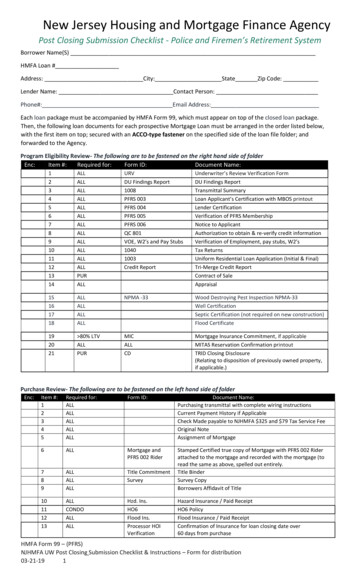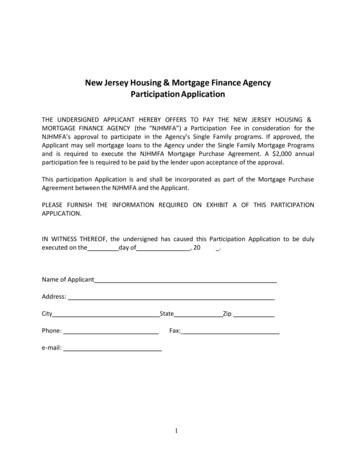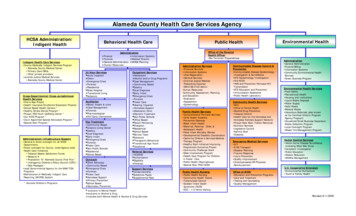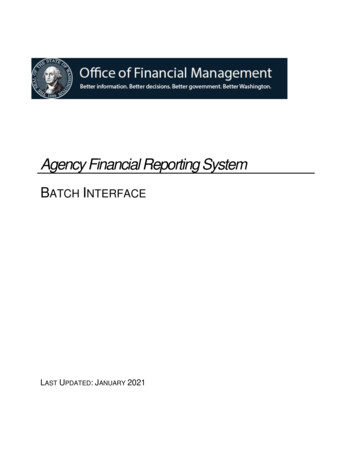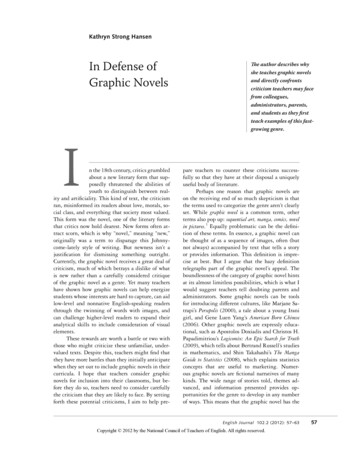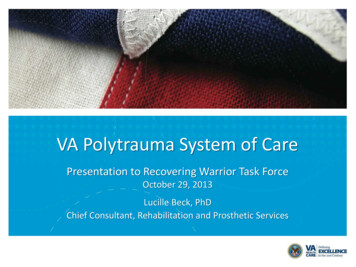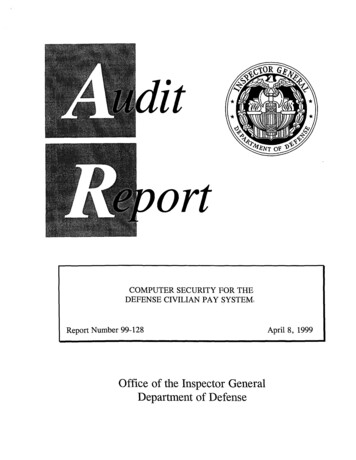
Transcription
DEFENSE HEALTH AGENCYNew System to Manage Nurses’ WorkloadsOptimizing Patient Care at Walter ReedJason J. CunninghamDefense AT&L: January-February 201822
Walter Reed National Military Medical Center, the nation’s largestmilitary treatment facility, faceda major challenge maintaining itsreputation for excellence: how tomodernize the aging system used to manage hoursfor a nursing staff of more than 7,000 without adversely affecting patient care for more than 1 millionbeneficiaries each year.The Clinical Support Program Management Office (PMO) and the formerCustomer Deployment Support Branch within the Solution Delivery Division (SDD) of the Defense Health Agency (DHA) answered the challengewith its May 22 release of the latest version of the Workload ManagementSystem for Nursing-internet (WMSNi)—WMSNi 2.0.WMSNi 2.0 is a Web-based Patient Classification System (PCS) used tocapture the number of nursing care hours needed by different patients, tofacilitate the distribution of available nurses among the patients. Knowinghow many hours of care each patient requires is essential to managingeach nurse’s workload. WMSNi 2.0 automates and simplifies the paper andmanual data entry process still used at many military hospitals and clinics.Background and Early DevelopmentIn 1955, Esther Claussen conducted the first patient classification study atWalter Reed. Her work produced the report “Nine Category Scale of PatientNeeds.” Modifications were made over the years until 1985 when the U.S.Army Nurse Corps and U.S. Navy Nurse Corps joined forces to develop thefirst paper-based iteration of WMSNi.Over time, the critical indicators that formed the backbone of the system nolonger reflected current practices. Changes in inpatient practices, technology and new regulations required a thorough review and revalidation of thenursing care hours associated with each indicator.An Army research team was assembled to look at each of the 99 criticalindicators at 26 military treatment facilities across the country. The teamperformed a series of time and motion studies for each nursing activity.According to one report in the U.S. Army Medical Department Journal, theseobservations were made on 60 different nursing duties and generated morethan 3,200 time measurements. The data formed the foundation of theCunningham is a member of the Stakeholder Engagement Branch of the Defense HealthAgency’s Solution Delivery Division. He covers advancements in health technology solutionsat military treatment centers worldwide.23Defense AT&L: January-February 2018
The Need to UpdateThe WMSNi team trained:544 staff members89 super users451 end usersWalter Reed Nurse Informatics Officer Army Maj. AngelHowell said the treatment facility was still using a paperbased, manual data entry system before implementingWMSNi 2.0. She called the process time consuming andprone to data entry errors and explained that Walter Reed“used the old DD2551 worksheet to capture nursing carehours and determine the acuity of each inpatient. This datawas then manually entered into a database to determine theappropriate staff mix.”In a 2011 U.S. Army Medical Department Center and Schoolsurvey of 105 nurses, 66 percent of respondents agreed orstrongly agreed that the legacy WMSNi was not optimal andFigure 1. A Tale of Two SystemsPre-Implementation Surveynext few generations of PCSs. “Second generation systems of the Legacy WMSN Systemwere designed to focus on patient care,” Kelle Harper andCrystal McCully explained in their December 2007 article inthe Nursing Administration Quarterly, “Acuity Systems Dialogueand Patient Classification System Essentials.”The legacy WMSN isnot optimal and doesnot meet our needs.“By the 1990s, third generation PCSs were critical due toshorter hospital stays and less stationary staff,” Harper andMcCully reported. “Fourth generation systems now focus onprospective modeling, evolving to provide real-time matchingof caregiver skill profiles to meet staffing needs for the currentand upcoming shifts.”NeutralAgree/StronglyAgreeHow easy is it to use thelegacy WMSN i 2.0 is the latest advance in the progression.Patient Classification Systems and WMSNiPost-Implementation Surveyof the WSMNi 2.0 SystemTwo types of workload management systems commonly areused in the nursing field: the summative task type and thecritical incident or criterion type.WMSNi provides aneffective way to document the inpatientclinical workload data.Harper and McCully explained that summative task PCSs“usually appear comprehensive because they list major tasksand tend to be easier to design and code to an interface.” However, they also noted that the criterion type can be more easilyadapted to the organization.Both systems provide similar benefits to users, includingdata-driven decision making, standardized documentationand—most crucially—integration with existing staff scheduling systems.OtherResponsesThe WMSNi 2.0 is a summative task PCS that presents a patient’s care requirements in terms of the frequency of tasks.WMSNi 2.0 is the latest, fourth-generation version of the unintuitive legacy WMSNi system that has been in use at manymilitary treatment facilities for years.Defense AT&L: January-February 2018Agree/StronglyAgreeWMSNi is easier touse and meets myneeds.OtherResponsesAgree/StronglyAgreeThe photographs and figures were produced by the DefenseHealth Agency’s Solution Delivery Division.24
Above and right: Staff at Walter Reed work with the new internet nursing workload management system.did not meet their needs. Forty-three percent rated it as frustrating and ineffective.At Walter Reed, the system was ripe for a major upgrade. “Wewent from a paper process to WMSNi 2.0, skipping WMSNi1.0,” Howell said. She noted that early WMSNi versions couldnot compare staffing needs at Walter Reed with those at otherfacilities, a feature they felt necessary.“The greatest benefit of WMSNi 2.0 will be the ability tobenchmark against other military treatment facilities withsimilar services/size,” Walter Reed Nurse Informaticist Sevgin Hunt added. “We are looking forward to an improvedability to trend and predict staffing needs with more reliable data.”Lt. Cmdr. Stephen Dunham, who works in the Walter ReedNursing Administration Business Cell, said he was often frustrated by an inability to compare or share data. “The greatestlimitation of the before-state was that none of the data wasformally recognized by DHA, AMEDD [Army Medical Department] or NAVMED [Navy Medical Department], so we couldonly use it as a local tool,” he said. “Now that we are using thesame system as every other Army medical treatment facility,25Defense AT&L: January-February 2018
.The balance of great leadership and vision, along with the team effortby the WMSNi representatives, including the data base and systemadministrators and the organized team members in charge of meetingnotes and scheduling, created a cohesive group prepared to work hardto make the deployment process run smoothly.we are on a level playing field. As the data mature, we canbegin using it to better inform decisions.”effort by the WMSNi representatives, including the data baseand system administrators and the organized team membersin charge of meeting notes and scheduling, created a cohesivegroup prepared to work hard to make the deployment processrun smoothly.WMSNi 2.0 allows staffing managers to directly comparethe staff they have scheduled against the staff the facilitywill need based on the required nursing care hours specifiedin the patient classification system. Managers can then reallocate staff and eliminate over- or understaffed units. WalterReed’s leaders believe this tool will improve facility staffingprojections, ensure staffing needs are met, and simultaneously document and analyze nursing workload, thereby improving patient safety.Impact After ImplementationTo date, approximately 30 percent of the units are producingreliable data that could be used to determine the long-termimpacts of the WMSNi 2.0 upgrade at Walter Reed NationalMilitary Medical Center.“It is too early to assess the impact of the WMSNi 2.0 solution,” Hunt said. “It is difficult to do a pre- and post-analysissince the paper system does not use the same calculations asthe computerized tool.”Smooth Deployment at Walter ReedThe successful WMSNi 2.0 deployment in May was the culmination of more than 9 months of work by the Clinical SupportPMO. In November 2016, the team began preparing for thetransition. Clinical Support deputy program manager YvonneHobson and Customer Deployment Support PMO liaison anddeployment operations chief Barbara Grossman and their respective teams held regular meetings to determine the predeployment checklist and the requirements needed to preparethe site to go-live with WMSNi 2.0. Starting 120 days from thelaunch date, the team met once a month to track the progress,risks and issues while working with Walter Reed to finalize allrequirements and complete training for 544 staff members,89 super users and 451 end users.The prospects look good for Walter Reed’s patients. A 2003multisite study by Dr. Sung-Hyun Cho in partnership withthe Agency for Healthcare Research and Quality found thatan increase of 1 hour worked by registered nurses per patient day correlated with an 8.9 percent decrease in theodds of pneumonia among surgical patients. Improved accuracy in scheduling clearly can have a direct impact onpatient care. WMSNi 2.0 also features special patient codesto account for the workload required by ambulatory andoutpatient visitors. Howell anticipates significant benefitsin forecasting staffing needs, which was difficult to do underthe old system.To ensure Walter Reed’s successful transition to the new system, the SDD WMSNi team did not treat the go-live date as afinish line. Instead, after the launch the level of communicationwas increased with the facility’s staff to ensure that the systemworked as expected. After the system was online for a month,the team began a series of post-implementation meetings withthe site staff to review their checklist and communicate postdeployment progress with the facility. Collaboration betweenthe SDD team and Walter Reed staff was critical to the seamless transition.“WMSNi 2.0 is a prospective system,” she explained. “Thuswe are optimistic that the deployment of WMSNi 2.0 will increase the accuracy in estimating workload and predictingdaily, monthly and annual staffing needs. We also hope tostreamline staffing requirements by comparing our nursingcare hour requirements to other DHA facilities.”As treatment facilities and program management officesthroughout the Military Health Services look to harness thepower of data in decision making, WMSNi 2.0 should provideboth the reflective and predictive analytics needed to ensurestaffing levels and staff expertise provide the best possiblecare to our Service members and their families.“The [Walter Reed] staff was supportive, willing and in constant communication with the WMSNi team,” Grossman said.“They were responsive, happy, and willing to make it work.”Project manager Ken Ross agreed, saying he believes that, ifnot for the team, nothing would have been completed. He saidthe balance of great leadership and vision, along with the teamDefense AT&L: January-February 2018The author can be contacted at Jason.j.cunningham5.ctr@mail.mil .26
Nursing Administration Business Cell, said he was often frus - trated by an inability to compare or share data. “The greatest limitation of the before-state was that none of the data was formally recognized by DHA, AMEDD [Army Medical Depart - ment] or NAVMED [Navy Medical Depart


